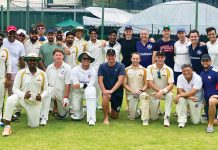 October is Breast Cancer Awareness month, a time when globally, we work together to raise awareness and remind women to keep up-to-date with their breast health. ANZA hold several Pink events around the island including our Pink Ladies Night in October. We wear our Pink Ribbons with pride. Singapore Cancer Society host a Race Against Cancer.
October is Breast Cancer Awareness month, a time when globally, we work together to raise awareness and remind women to keep up-to-date with their breast health. ANZA hold several Pink events around the island including our Pink Ladies Night in October. We wear our Pink Ribbons with pride. Singapore Cancer Society host a Race Against Cancer.
Despite the knowledge and awareness we have in 2023, the devastating news is that in most high-income countries, breast cancer remians the leading cause of cancer in women (after skin cancers) and the second leading cause of death (after lung cancer). There is a 1 in 8 chance that a woman will develop breast cancer and breast cancer incidence has been increasing over the past few decades.
Thankfully, research is ongoing to bring better knowledge. However, this does mean that it can sometimes be tricky to know what’s best when it comes to preventative measures as new discoveries are made. In 2023, is a self-breast check the first step when it comes to breast cancer? How often is a mammogram required for women living in Singapore today? Here, we speak to Dr Jacqueline Dukino from IMC Camden (who’ve been operating in SG for 25 years) who puts us straight on recent findings and new terminology to keep women around the world as healthy and informed abour breast cancer as possible.
The Ins & Outs for the early detection of breast cancer
IN…Mammograms
Mammography is a crucial health screening test, and it has been demonstrated that regular mammogram screening tests improve morbidity and mortality through early detection of breast cancer. A mammogram is a low-dose breast X-ray that can detect changes consistent with breast cancer. There have been improvements in mammogram techniques, with both 3D and 2D mammograms now available.
Other screening modalities may be used for women with a higher than average risk of breast cancer, including mammograms with breast ultrasound and breast MRI.
The guidelines for mammogram screening programmes vary between different countries and sometimes between different health governing bodies in one country. This may lead to some confusion, but in general, most places are moving to screening at a younger age (from age 40) and more frequent screening for younger women (annual screening) due to the increased risk of high breast density and faster-growing breast cancers in this age group.
Singapore recommends annual mammograms for women aged 40-49 (after discussion with a doctor) and once every two years for women over 50.
OUT (sort of) … Breast Self-Examination
Breast self-examination used to be the first line in the “screening programme” for breast cancer. However, about 15 years ago, studies demonstrated no difference in mortality between women who just underwent mammography screening and those who had mammography and regular self-beast examination. This research, along with studies that demonstrated an increased risk of over investigation of benign breast changes, prompted a change in the guidelines in several countries to remove monthly breast self-examination and focus more on “breast awareness”.
Wait – this is not to say that breast self-examination is not still vital. Being “breast aware” means knowing what your breasts feel and look like so keep your wits about you. If any changes in your breast are noted, for example lumps, skin changes, or nipple discharge, then you should present to your doctor straight away.
OUT (sort of) … Clinical Breast Examination
This is an examination by a health professional. In a number of countries, this has actually been removed from the screening guidelines, but a breast examination by a doctor is still essentail in women at higher than average risk of breast cancer (e.g. due to past history or a family history of breast cancer). As mentioned above, a breast examination is also essential if a woman presents with symptoms.
 So, what should women do in 2023?
So, what should women do in 2023?
The important takeaway message with the change from self-breast examination to breast awareness is that if you detect any changes or have concerns regarding your breasts, you see your doctor for further examination and discussion regarding the appropriate investigations.
Other factors to consider are breast cancer risk assessment and preventative measures. Breast cancer risk assessment is key to identifying women with a higher risk of breast cancer. The important factors are past medical history, past history of breast issues and a comprehensive family history of cancer (particularly breast and ovarian cancer).
Genetic testing may also play an important role in this assessment, and with the decreasing costs of genetic tests and a number of genes being identified as potentially increasing the risk of breast cancer, including the BRCA genes, some health governing bodies in the USA are recommending breast cancer risk assessments in all women at the age of 25. In the future, these breast cancer risk assessments may lead to individualised risk-based screening programs rather than the age-based screening that is currently used.
Preventative measures that are important to try and decrease the risk of developing breast cancer include physical activity, maintaining a normal BMI (post-menopause), decreasing alcohol consumption and consuming a Mediterranean diet. For women with moderate to high risk of breast cancer, there may be a role for risk-reducing medication, and for women with high risk (e.g. BRCA gene positive – ) risk-reducing surgery.
So for this October – Breast Cancer Awareness month – consider seeing your doctor to organise breast cancer screening (mammogram) if it is indicated and for a breast cancer risk assessment.
*Sources: Health Promotion Board Singapore, RACGP Red Book “Early Detection of Cancers, – Breast Cancer”, Breast Cancer Foundation NZ, American Cancer Society “Recommendations for the Early Detection of Breast Cancer”, Breast Cancer Research Foundation “What to know about New Breast Cancer Screening Recommendations”.



 So, what should women do in 2023?
So, what should women do in 2023?




